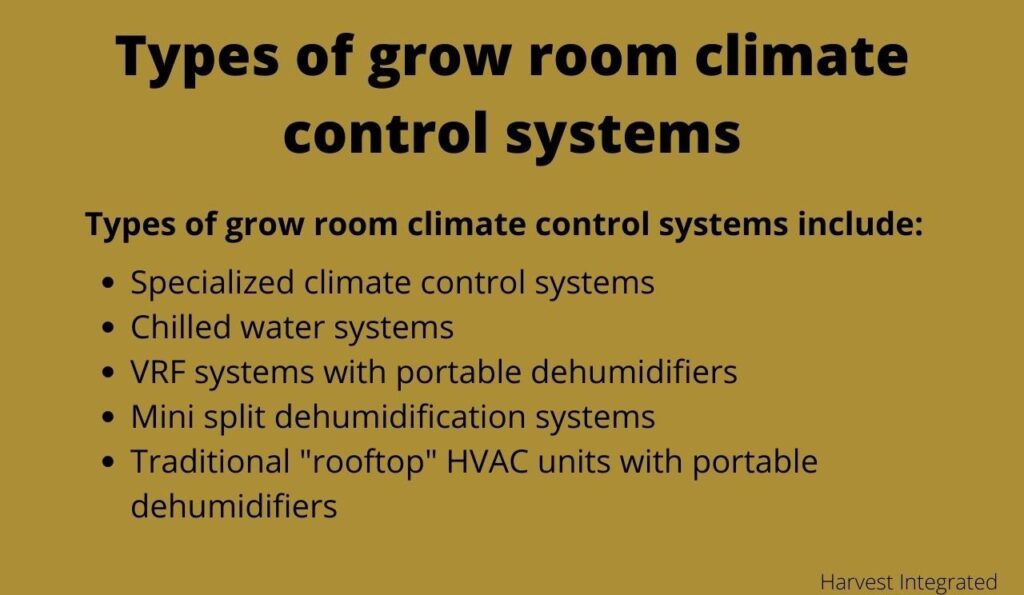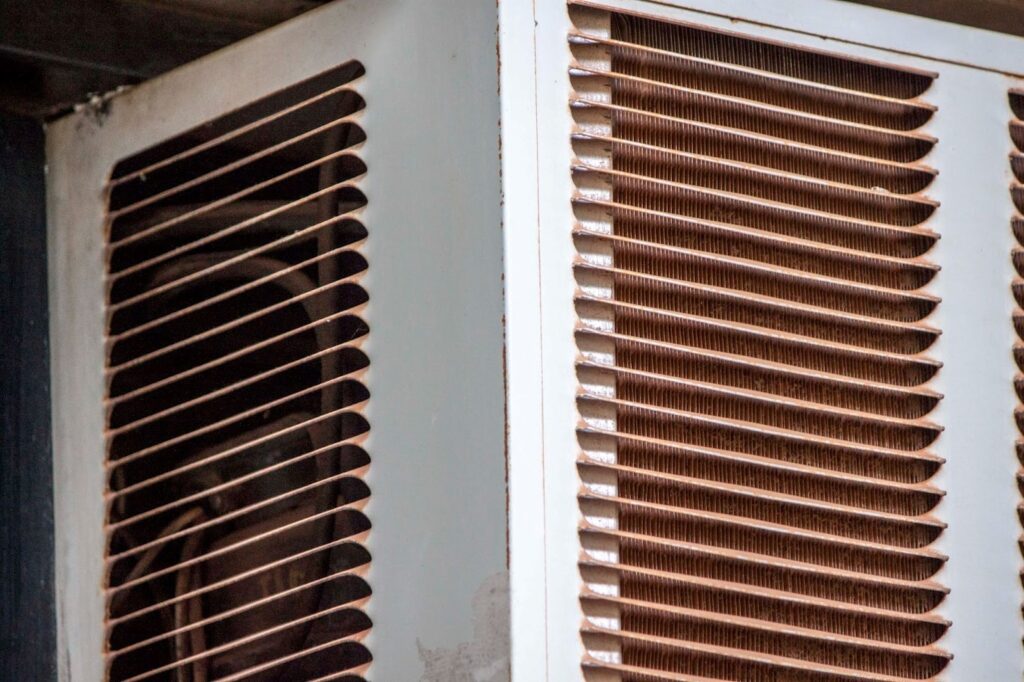Not so many ecosystems can compare to an indoor grow room — the space is vibrant, to say the least. You have to cater to and optimize for a lot of environmental conditions in one go; from temperature and relative humidity to airflow, carbon dioxide and odors. Doing this requires having a robust grow room climate control system. This leads us to an all-important question…
Why is choosing the right grow room climate system important?
Your choice of climate control system will affect every aspect of your grow operation and business goals. And we mean every aspect. Whether it’s your crop quality, profitability, future growth, or even your ability to meet sustainability goals, your grow room climate control system will affect it all.
Because of the significant impact your grow room climate control system has, it’s important to choose one that will help optimize your operation from the outset.
And how do you do that?
You start by looking at the different types of climate control systems, complete with their advantages and drawbacks.
Types of grow room climate control systems
There are many climate control system options on the market, but some common ones include:

Traditional “rooftop” systems with portable dehumidifiers
With this setup, growers install rooftop air conditioners. The problem with the traditional air conditioners is that they are primarily built for comfort cooling, and humidity control is not a priority. As such, they only remove a small amount of moisture from the grow space. This is where the portable dehumidifiers come in, making up for the shortcomings of the air conditioners by dehumidifying the space and working to create an ideal grow environment.
There’s a problem with this setup though — the air conditioners and the dehumidifiers compete. As the dehumidifiers work and produce heat, the air conditioner switches on to try and remove the excess heat, only to switch off again when the heat has been removed. Unfortunately, this frequent switching on/off of the air conditioner makes it susceptible to dying much sooner. What’s more, this system causes major humidity and temperature swings in the grow space, increasing the risk of mold growth, poor crop quality and reduced yields.
Another issue with this traditional rooftop setup is that you’ll likely need reheating equipment to ensure that you don’t overcool the grow facility. However, reheat options tend to be expensive; you’ll have to account for their acquisition costs and the operating and maintenance costs you’ll incur. Additionally, since the air conditioners and dehumidifiers are not in sync, if you adjust the temperature of the rooftop unit, you’ll need to adjust each dehumidifier independently to keep up with the temperature change.
When you weigh all these drawbacks and inefficiencies, it’s easy to see why traditional rooftop units are not ideal for building a profitable operation.
Pros
- Cheap option
- Easy installation
- Simple maintenance
Cons
- Not a tailored option. Made for comfort cooling, not plants
- Lack of precision. Very poor temperature and humidity control
- High energy costs
- Makes grow room highly susceptible to biological contaminants
- May require a backup heating system to ensure that the grow room doesn’t overcool
- Requires individual adjustment of each dehumidifier if air conditioner temperature is adjusted
Mini split dehumidification systems
As the name implies, mini split systems comprise split systems; they are not central and so don’t come with the extensive ductwork of centralized climate control systems. Mini split systems come with two main components:
- The air handler that distributes cool air. This component is usually placed indoors and mounted to the wall, ceiling or floor.
- The condenser that expels moisture and heated air created during the cooling process. This component is usually installed outside.
The two components are connected via a refrigerant line and conductor wire.
Mini splits are inexpensive and easy to install. They are also more efficient compared to other conventional climate control systems since they are ductless. About 30% of all air produced by central cooling systems is lost as it moves through the ducts, therefore, mini split systems offer better efficiency and contribute to significant reductions in energy use.
However, similar to traditional rooftop units, mini split systems are made for comfort cooling. This means that their application to grow rooms comes with limitations. Although they can remove moisture from the grow room, mini splits will usually need the help of separate dehumidifiers. Additionally, long-term users of mini split systems often have to deal with mold that collects in the indoor blowers, and there are also issues with frequent system breakdowns and difficult cleaning.
Mini split systems may be a good option for small scale growers or growers on a budget, but their drawbacks mean they are not a viable option for professional grow facilities.
Pros
- Cheap option
- Easy installation
- Offer better efficiency compared to other conventional systems, resulting in lower energy bills
Cons
- Not a purpose-built option. Made for comfort cooling, not plants
- Lack of precise humidity and temperature control
- Usually needs additional dehumidifiers
- Makes grow room susceptible to biological contaminants
- Difficult to clean
VRF systems with portable dehumidifiers
Variable Refrigerant Flow (VRF) systems use refrigerant for cooling and heating. They are characterized by multiple indoor units connected to a single outdoor condensing unit with multiple refrigerant piping runs. The refrigerant is conditioned by the outside unit and circulated in the grow space through multiple fan coils.
VRF systems are similar to traditional rooftop units and mini splits — they are a comfort cooling solution adapted to grow rooms. As such, when applied to cultivation facilities, they require additional dehumidifiers to help with the dehumidification. In most cases, growers end up with massive temperature and humidity swings that create a less-than-ideal grow environment. Just like rooftop cooling units, VRF units also compete with the dehumidifiers, and the frequent on/off of the VRF units causes their compressors to break down much sooner.
But while VRF systems share some similarities with mini split systems and rooftop units, they come with a bigger set of challenges. First, having multiple units deliver cold air to plants causes condensation to form on plant leaves; this puts the plants at risk of developing mold. Second, the very high levels of refrigerant being pumped into the grow space can be very dangerous and unhealthy if there is a leak. Finally, the existence of fans and compressors between the system and portable dehumidifiers means growers are faced with even more potential failure points and they have to be prepared for more repair and maintenance costs.
VRF systems are generally energy efficient though, since they are purposely designed to supply the right amount of refrigerant to every indoor unit. This reduces energy waste and makes the systems more efficient. Do note, however, that the efficiency of VRF systems is marginal compared to more superior grow room climate control systems.
Pros
- Energy efficiency provides marginally lower energy usage compared to rooftop units. This helps reduce the long-term costs of electricity bills
- An “off the shelf” solution so no need for complex designing
Cons
- Not a purpose-built option. Made for comfort cooling, not plants
- Lack of precise temperature and humidity control
- Energy usage still very high compared to other climate control systems
- Puts plant at risk of biological contamination
- High levels of refrigerant pose a threat if there is a leak
- System installation is generally more expensive compared to other options
- May require a backup heating system to prevent grow space overcooling
- Has more potential failure points compared to other systems
- Requires individual adjustment of each dehumidifier if VRF system temperature is adjusted

Chilled water systems
Compared to the climate control systems we’ve looked at so far, chilled water systems are a better option — they are more geared towards grow rooms. With a chilled water system, a large outdoor unit chills water which is then piped into multiple indoor units for dehumidification and cooling. Reheat coils keep the grow space from overcooling.
Chiller systems use water piping instead of refrigerant piping. The biggest advantage of this is that, compared to refrigerant, chilled water can be piped much further. Chilled water systems also provide good energy efficiency compared to the aforementioned systems, plus they can be a cost-effective option for larger grow facilities with larger cooling and dehumidification loads.
The main issue with chilled water systems is their complexity, not only in terms of design, but also all the equipment involved. Chiller systems have a lot of different components, and most times, these components come from various sources. For instance, the extensive water piping throughout the grow facility may not be sourced from the same place as the pumps that send water through the pipes. Additionally, the chiller system has to be paired with indoor units made for grow rooms, but the indoor units and chillers may come from different manufacturers. With too many equipment providers involved, getting solutions as problems arise may be difficult.
Adding to this problem are the potential redundancy issues should the chiller break and the fact that the various system components can be expensive to maintain and repair.
Pros
- High energy efficiency compared to conventional air conditioning solutions
- Better temperature and humidity control which contributes to a better quality crop and higher yields
- Potential scalability if well thought out
Cons
- Costly
- Complex system design
- Electric reheat coils usually consume a lot of energy, resulting in high electricity costs
- Potential redundancy issues if the chiller breaks
- Large equipment can be extremely expensive to repair
- Requires specialized maintenance and service
- Equipment is usually sourced from multiple third-party contractors. This reduces accountability and makes it harder to get answers when problems arise
Fortunately, where chilled water systems fall short, specialized climate control systems get the job done.
Specialized climate control systems
Most conventional grow room climate control systems are designed to control temperature, with dehumidification as an afterthought. This makes them ineffective when it comes to catering to the rigorous environmental requirements of grow rooms. Take cannabis climate control for example. With varying environmental requirements at each stage of the growth cycle, indoor cannabis cultivation requires a specialized environment to thrive. This, in turn, calls for specialized climate control. The risk of losses is simply too high in grow rooms with poor climate control.
Specialized grow room climate control systems deliver precise grow conditions at every stage of the growth cycle. This means that you get to control temperature, humidity and airflow all in one package. What’s more, you can easily remove heat or add it back into the grow space as required whether it’s a lights-on or lights-off cycle.
Consider this scenario. Air conditioning units and dehumidifiers that are independent of each other tend to create uneven air distribution, forming condensation and micro climates. This creates an opportunity for pests and pathogens to thrive, a situation that can only leave you counting some losses and something you want to avoid at all costs. Specialized systems, on the other hand, ensure that you control the environment accurately. Simply put, specialized systems make up for the shortcomings of traditional solutions, separate air conditioners and separate dehumidifiers.
Take Harvest Air™ for example. The system is a fully-packaged, single unit that’s designed with both cooling and dehumidification capabilities. This system can match the cooling and dehumidification load at every grow cycle stage with precision, allowing you to handle specialized environments, e.g. cannabis, without needing any extra reheating or dehumidification equipment. Harvest Air™ gives growers the ability to fine-tune control of their grows, ensuring that they see very healthy plants and robust yields.

Compared to the limitations of traditional climate control systems such as inefficient energy use and the lack of flexibility, redundancy and scalability, specialized systems provide many benefits that will help you grow your operation. Their biggest downside, however, is their cost — specialized systems require a large investment.
Pros
- Purpose-built system
- Extremely precise temperature and humidity control
- Energy efficiency
- Built-in redundancy
- Scalability
- Fewer total number of pieces of equipment (fewer bits to maintain or fail)
- Easy, cost-efficient maintenance
- Consistent product quality resulting in higher crop yield and profit potential
Cons
- Higher up-front cost
- Complex design
Not having a specialized system is one of the common challenges to scaling a grow operation in a manner that’s efficient and economical. But if you’re new to specialized climate control systems, and you’re not sure why they deserve your attention, don’t worry. We have put together five reasons to help you understand.
After the type, then what? More things to consider when choosing a grow room climate control system
Types of systems aside, the following are other important factors that will help you choose the best grow room climate control system for your operation.
Your needs
No two grow rooms are the same. A climate control system that works for one grow won’t necessarily work for the next — there’s no universal solution. Your choice should depend on your needs, how much precision and control you want in the facility, and of course, your budget.
Speaking of budget, cost is another important factor you have to take into consideration when choosing a system.
Cost
The grow room climate control system you choose should make economical sense. When considering the cost of the system, don’t just think of equipment cost in isolation. You’ll also need to factor in things such as installation costs and annual costs. Annual costs will include your operating costs (e.g. energy costs) and maintenance costs to keep your system in the best condition.
Your grow room climate control system will be one of the largest costs you incur in your operation, however, be careful not to fall into the cost trap. It’s tempting to opt for short-term savings by getting a climate control system that’s not quite what you want, but this can have a long-term negative impact on your profits and business sustainability.
To avoid making short-sighted cost decisions, aim to strike a balance between your bottom line and upfront costs with the short and long term impacts of your choice, particularly when it comes to efficiency and long-term cost effectiveness. A system that costs more upfront, but is more efficient and will save money in the long run is worth the spend compared to a cheaper alternative that will cost you more in the long term (think poor efficiency coupled with high energy and maintenance bills).

That said, be careful not to buy an expensive climate control system just because it’s popular. If it doesn’t make sense for your unique operation and won’t add any value, don’t buy it. Knowing exactly what you need for your grow can be difficult, which is why it’s important to enlist the help of experts when choosing a climate control system.
Expert help
Specificity is key when it comes to grow room climate control. Generalist consultants and engineers simply don’t have the expertise required in the niche area that is specialized grow room climate control.
On the other hand, expert consultants understand grow room equipment, operations, diagnostics and the complex nature of grow room climate control. They will be able to help you pick a system based on crucial factors such as your facility size, crop type, geography, precision requirements, redundancy requirements and budget. With their help, you can offset the higher upfront costs. For instance, experts can help you design and set up an efficient system that results in massive long-term cost savings, plus they can help you secure energy rebates that lower the cost of your climate control system.
Additionally, grow room climate control system experts can help lower your initial investment. Consider Harvest Power™. This system offers flexibility, allowing you to scale as your business grows. There’s no need to pay for what you don’t need so you can use your money elsewhere where it’s required to grow your operation.
Not sure how to choose the right team to help you choose your grow room climate control system? Here’s our guide to choosing the right grow room HVAC consultant for your operation.
Choosing your grow room climate control system
As you can see, there are many factors to keep in mind when choosing a climate control system that will help optimize your operation. The important thing is to choose a system that supports your unique needs and business goals. And one more thing — be skeptical of the “one-size-fits-all” type of systems.